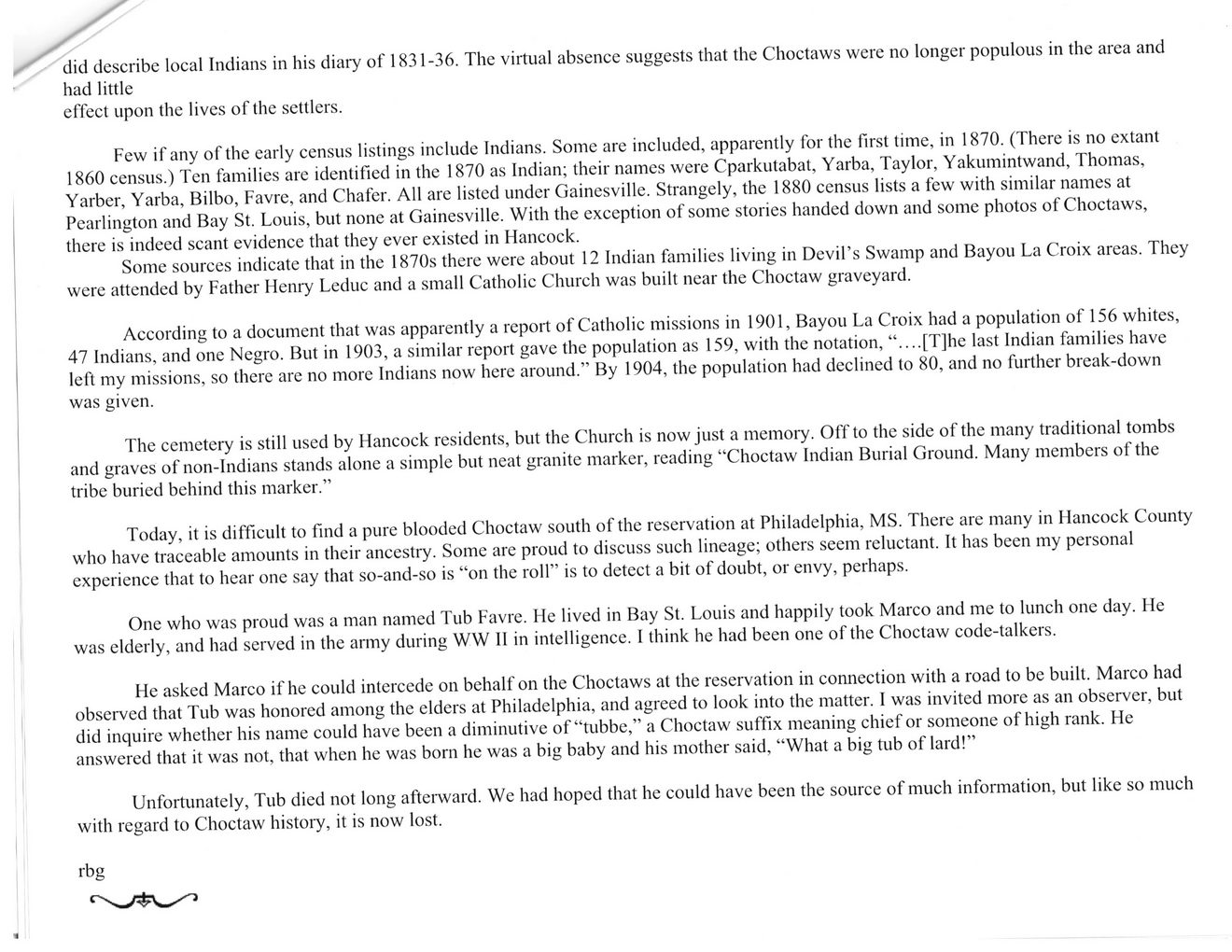This text was obtained via automated optical character recognition.
It has not been edited and may therefore contain several errors.
did describe local Indians in his diary of 1831-36. The virtual absence suggests that the Choctaws were no longer populous in the area and had little effect upon the lives of the settlers. Few if any of the early census listings include Indians. Some are included, apparently for the first time, in 1870. (There is no extant 1860 census.) Ten families are identified in the 1870 as Indian; their names were Cparkutabat, Yarba, Taylor, Yakumintwand, Thomas, Yarber, Yarba, Bilbo, Favre, and Chafer. All are listed under Gainesville. Strangely, the 1880 census lists a few with similar names at Pearlington and Bay St. Louis, but none at Gainesville. With the exception of some stories handed down and some photos of Choctaws, there is indeed scant evidence that they ever existed in Hancock. Some sources indicate that in the 1870s there were about 12 Indian families living in Devil’s Swamp and Bayou La Croix areas. They were attended by Father Henry Leduc and a small Catholic Church was built near the Choctaw graveyard. According to a document that was apparently a report of Catholic missions in 1901, Bayou La Croix had a population of 156 whites, 47 Indians, and one Negro. But in 1903, a similar report gave the population as 159, with the notation, “,...[T]he last Indian families have left my missions, so there are no more Indians now here around.” By 1904, the population had declined to 80, and no further break-down was given. The cemetery is still used by Hancock residents, but the Church is now just a memory. Off to the side of the many traditional tombs and graves of non-Indians stands alone a simple but neat granite marker, reading “Choctaw Indian Burial Ground. Many members of the tribe buried behind this marker.” Today, it is difficult to find a pure blooded Choctaw south of the reservation at Philadelphia, MS. There are many in Hancock County who have traceable amounts in their ancestry. Some are proud to discuss such lineage; others seem reluctant. It has been my personal experience that to hear one say that so-and-so is “on the roll” is to detect a bit of doubt, or envy, perhaps. One who was proud was a man named Tub Favre. He lived in Bay St. Louis and happily took Marco and me to lunch one day. He was elderly, and had served in the army during WW II in intelligence. I think he had been one of the Choctaw code-talkers. He asked Marco if he could intercede on behalf on the Choctaws at the reservation in connection with a road to be built. Marco had observed that Tub was honored among the elders at Philadelphia, and agreed to look into the matter. I was invited more as an observer, but did inquire whether his name could have been a diminutive of “tubbe,” a Choctaw suffix meaning chief or someone of high rank. He answered that it was not, that when he was born he was a big baby and his mother said, “What a big tub of lard!” Unfortunately, Tub died not long afterward. We had hoped that he could have been the source of much information, but like so much with regard to Choctaw history, it is now lost. rbg

Choctaws of Hancock County Guerin-Article-2006-(5)